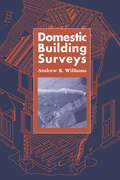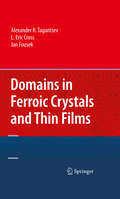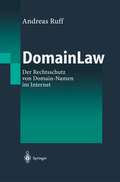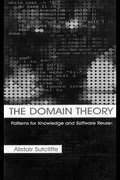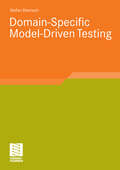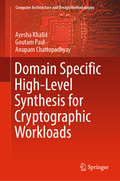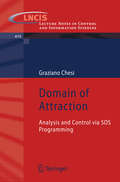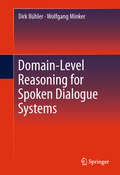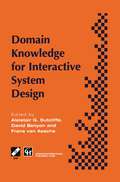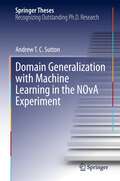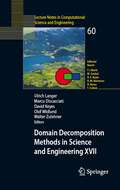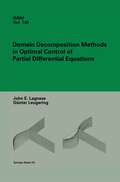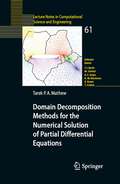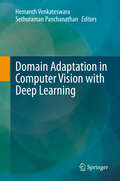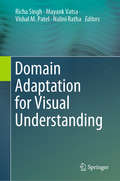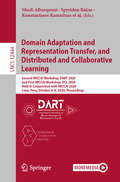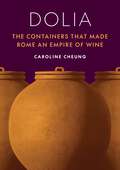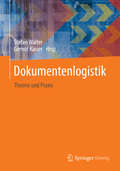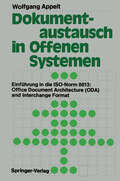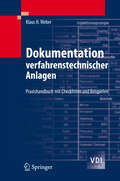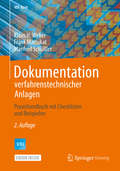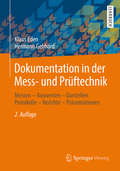- Table View
- List View
Domestic Building Surveys
by Andrew WilliamsThis is a practical guide showing how to undertake a domestic building survey. The text describes the practical aspects of surveying with a full description of the author's own experience, at the same time drawing out the important principles involved.
Domestic Building Surveys
by Andrew WilliamsThis is a practical guide showing how to undertake a domestic building survey. The text describes the practical aspects of surveying with a full description of the author's own experience, at the same time drawing out the important principles involved.
Domains in Ferroic Crystals and Thin Films
by Alexander Tagantsev L. Eric Cross Jan FousekAt present, the marketplace for professionals, researchers, and graduate students in solid-state physics and materials science lacks a book that presents a comprehensive discussion of ferroelectrics and related materials in a form that is suitable for experimentalists and engineers. This book proposes to present a wide coverage of domain-related issues concerning these materials. This coverage includes selected theoretical topics (which are covered in the existing literature) in addition to a plethora of experimental data which occupies over half of the book. The book presents experimental findings and theoretical understanding of ferroic (non-magnetic) domains developed during the past 60 years. It addresses the situation by looking specifically at bulk crystals and thin films, with a particular focus on recently-developed microelectronic applications and methods for observations of domains with techniques such as scanning force microscopy, polarized light microscopy, scanning optical microscopy, electron microscopy, and surface decorating techniques. "Domains in Ferroic Crystals and Thin Films" covers a large area of material properties and effects connected with static and dynamic properties of domains, which are extremely relevant to materials referred to as ferroics. In other textbooks on solid state physics, one large group of ferroics is customarily covered: those in which magnetic properties play a dominant role. Numerous books are specifically devoted to magnetic ferroics and cover a wide spectrum of magnetic domain phenomena. In contrast, "Domains in Ferroic Crystals and Thin Films" concentrates on domain-related phenomena in nonmagnetic ferroics. These materials are still inadequately represented in solid state physics textbooks and monographs.
DomainLaw: Der Rechtsschutz von Domain-Namen im Internet
by Andreas RuffDas Buch gibt einen umfassenden Überblick über das DomainLaw - dem Namens- und Kennzeichenrecht im Internet. Behandelt werden zentrale Bereiche des DomainLaw wie beispielsweise das Vergabeverfahren sowie der nationale, europäische und internationale Rechtsschutz von Domain-Namen. Eine Reihe potentieller Rechtsprobleme werden dargestellt, die es zu wissen gilt, wenn man selbst Domaininhaber/in ist oder sich anderweitig mit diesem Bereich beschäftigt. Das Werk dient als zuverlässiger und verständlicher Rechtsberater, um sich in dem sehr komplexen Bereich des Namens- und Kennzeichenrechts im Internet orientieren zu können. Es richtet sich sowohl an Praktiker aus Wirtschaft, Justiz und Anwaltschaft, als auch an Studierende und Wissenschaftler.
The Domain Theory: Patterns for Knowledge and Software Reuse
by Alistair Sutcliffe A.G. SutcliffeIs this book about patterns? Yes and no. It is about software reuse and representation of knowledge that can be reapplied in similar situations; however, it does not follow the classic Alexandine conventions of the patterns community--i.e. Problem- solution- forces- context- example, etc. Chapter 6 on claims comes close to classic patterns, an
Domain-Specific Model-Driven Testing (Software Engineering Research)
by Stefan BärischStefan Baerisch applies a combination of feature modelling and code generation, for which he uses a model-driven approach, in order to facilitate the design of tests by non-programmers. This combination of modelling and code generation allows for a more integrated and more efficient testing process.
Domain Specific High-Level Synthesis for Cryptographic Workloads (Computer Architecture and Design Methodologies)
by Ayesha Khalid Goutam Paul Anupam ChattopadhyayThis book offers an in-depth study of the design and challenges addressed by a high-level synthesis tool targeting a specific class of cryptographic kernels, i.e. symmetric key cryptography. With the aid of detailed case studies, it also discusses optimization strategies that cannot be automatically undertaken by CRYKET (Cryptographic kernels toolkit. The dynamic nature of cryptography, where newer cryptographic functions and attacks frequently surface, means that such a tool can help cryptographers expedite the very large scale integration (VLSI) design cycle by rapidly exploring various design alternatives before reaching an optimal design option. Features include flexibility in cryptographic processors to support emerging cryptanalytic schemes; area-efficient multinational designs supporting various cryptographic functions; and design scalability on modern graphics processing units (GPUs). These case studies serve as a guide to cryptographers exploring the design of efficient cryptographic implementations.
Domain of Attraction: Analysis and Control via SOS Programming (Lecture Notes in Control and Information Sciences #415)
by Graziano ChesiFor nonlinear dynamical systems, which represent the majority of real devices, any study of stability requires the investigation of the domain of attraction of an equilibrium point, i.e. the set of initial conditions from which the trajectory of the system converges to equilibrium. Unfortunately, both estimating and attempting to control the domain of attraction are very difficult problems, because of the complex relationship of this set with the model of the system. Domain of Attraction addresses the estimation and control of the domain of attraction of equilibrium points via SOS programming, i.e. optimization techniques based on the sum of squares of polynomials (SOS) that have been recently developed and that amount to solving convex problems with linear matrix inequality constraints. A unified framework for addressing these issues is presented for in various cases depending on the nature of the nonlinear systems considered, including the cases of polynomial, non-polynomial, certain and uncertain systems. The methods proposed are illustrated various example systems such as electric circuits, mechanical devices, and nuclear plants. Domain of Attraction also deals with related problems that can be considered within the proposed framework, such as characterizing the equilibrium points and bounding the trajectories of nonlinear systems, and offers a concise and simple description of the main features of SOS programming, which can be used for general purpose in research and teaching.
Domain-Level Reasoning for Spoken Dialogue Systems
by Dirk Bühler Wolfgang MinkerReasoning for Information: Seeking and Planning Dialogues provides a logic-based reasoning component for spoken language dialogue systems. This component, called Problem Assistant is responsible for processing constraints on a possible solution obtained from various sources, namely user and the system's domain-specific information. The authors also present findings on the implementation of a dialogue management interface to the Problem Assistant. The dialogue system supports simple mixed-initiative planning interactions in the TRAINS domain, which is still a relatively complex domain involving a number of logical constraints and relations forming the basis for the collaborative problem-solving behavior that drives the dialogue.
Domain Knowledge for Interactive System Design (IFIP Advances in Information and Communication Technology)
by Alistair G. Sutcliffe Frans Van Assche David BenyonThis book describes how domain knowledge can be used in the design of interactive systems. It includes discussion of the theories and models of domain, generic domain architectures and construction of system components for specific domains. It draws on research experience from the Information Systems, Software Engineering and Human Computer Interaction communities.
Domain Generalization with Machine Learning in the NOvA Experiment (Springer Theses)
by Andrew T.C. SuttonThis thesis presents significant advances in the use of neural networks to study the properties of neutrinos. Machine learning tools like neural networks (NN) can be used to identify the particle types or determine their energies in detectors such as those used in the NOvA neutrino experiment, which studies changes in a beam of neutrinos as it propagates approximately 800 km through the earth. NOvA relies heavily on simulations of the physics processes and the detector response; these simulations work well, but do not match the real experiment perfectly. Thus, neural networks trained on simulated datasets must include systematic uncertainties that account for possible imperfections in the simulation. This thesis presents the first application in HEP of adversarial domain generalization to a regression neural network. Applying domain generalization to problems with large systematic variations will reduce the impact of uncertainties while avoiding the risk of falsely constraining the phase space. Reducing the impact of systematic uncertainties makes NOvA analysis more robust, and improves the significance of experimental results.
Domain Decomposition Methods in Science and Engineering XVII (Lecture Notes in Computational Science and Engineering #60)
by Ulrich Langer Marco Discacciati David E. Keyes Olof Widlund Walter ZulehnerDomain decomposition is an active, interdisciplinary research field concerned with the development, analysis, and implementation of coupling and decoupling strategies in mathematical and computational models. This volume contains selected papers presented at the 17th International Conference on Domain Decomposition Methods in Science and Engineering. It presents the newest domain decomposition techniques and examines their use in the modeling and simulation of complex problems.
Domain Decomposition Methods in Science and Engineering XVI (Lecture Notes in Computational Science and Engineering #55)
by Olof Widlund David E. KeyesDomain decomposition is an active research area concerned with the development, analysis, and implementation of coupling and decoupling strategies in mathematical and computational models of natural and engineered systems. The present volume sets forth new contributions in areas of numerical analysis, computer science, scientific and industrial applications, and software development.
Domain Decomposition Methods in Optimal Control of Partial Differential Equations (International Series of Numerical Mathematics #148)
by John E. Lagnese Günter LeugeringWhile domain decomposition methods have a long history dating back well over one hundred years, it is only during the last decade that they have become a major tool in numerical analysis of partial differential equations. This monograph emphasizes domain decomposition methods in the context of so-called virtual optimal control problems and treats optimal control problems for partial differential equations and their decompositions using an all-at-once approach.
Domain Decomposition Methods for the Numerical Solution of Partial Differential Equations (Lecture Notes in Computational Science and Engineering #61)
by Tarek MathewDomain decomposition methods are divide and conquer computational methods for the parallel solution of partial differential equations of elliptic or parabolic type. The methodology includes iterative algorithms, and techniques for non-matching grid discretizations and heterogeneous approximations. This book serves as a matrix oriented introduction to domain decomposition methodology. A wide range of topics are discussed include hybrid formulations, Schwarz, and many more.
Domain Adaptation in Computer Vision with Deep Learning
by Hemanth Venkateswara Sethuraman PanchanathanThis book provides a survey of deep learning approaches to domain adaptation in computer vision. It gives the reader an overview of the state-of-the-art research in deep learning based domain adaptation. This book also discusses the various approaches to deep learning based domain adaptation in recent years. It outlines the importance of domain adaptation for the advancement of computer vision, consolidates the research in the area and provides the reader with promising directions for future research in domain adaptation.Divided into four parts, the first part of this book begins with an introduction to domain adaptation, which outlines the problem statement, the role of domain adaptation and the motivation for research in this area. It includes a chapter outlining pre-deep learning era domain adaptation techniques. The second part of this book highlights feature alignment based approaches to domain adaptation. The third part of this book outlines image alignment procedures for domain adaptation. The final section of this book presents novel directions for research in domain adaptation. This book targets researchers working in artificial intelligence, machine learning, deep learning and computer vision. Industry professionals and entrepreneurs seeking to adopt deep learning into their applications will also be interested in this book.
Domain Adaptation for Visual Understanding
by Richa Singh Mayank Vatsa Vishal M. Patel Nalini RathaThis unique volume reviews the latest advances in domain adaptation in the training of machine learning algorithms for visual understanding, offering valuable insights from an international selection of experts in the field. The text presents a diverse selection of novel techniques, covering applications of object recognition, face recognition, and action and event recognition.Topics and features: reviews the domain adaptation-based machine learning algorithms available for visual understanding, and provides a deep metric learning approach; introduces a novel unsupervised method for image-to-image translation, and a video segment retrieval model that utilizes ensemble learning; proposes a unique way to determine which dataset is most useful in the base training, in order to improve the transferability of deep neural networks; describes a quantitative method for estimating the discrepancy between the source and target data to enhance image classification performance; presents a technique for multi-modal fusion that enhances facial action recognition, and a framework for intuition learning in domain adaptation; examines an original interpolation-based approach to address the issue of tracking model degradation in correlation filter-based methods.This authoritative work will serve as an invaluable reference for researchers and practitioners interested in machine learning-based visual recognition and understanding.
Domain Adaptation and Representation Transfer, and Distributed and Collaborative Learning: Second MICCAI Workshop, DART 2020, and First MICCAI Workshop, DCL 2020, Held in Conjunction with MICCAI 2020, Lima, Peru, October 4–8, 2020, Proceedings (Lecture Notes in Computer Science #12444)
by Shadi Albarqouni Spyridon Bakas Konstantinos Kamnitsas M. Jorge Cardoso Bennett Landman Wenqi Li Fausto Milletari Nicola Rieke Holger Roth Daguang Xu Ziyue XuThis book constitutes the refereed proceedings of the Second MICCAI Workshop on Domain Adaptation and Representation Transfer, DART 2020, and the First MICCAI Workshop on Distributed and Collaborative Learning, DCL 2020, held in conjunction with MICCAI 2020 in October 2020. The conference was planned to take place in Lima, Peru, but changed to an online format due to the Coronavirus pandemic. For DART 2020, 12 full papers were accepted from 18 submissions. They deal with methodological advancements and ideas that can improve the applicability of machine learning (ML)/deep learning (DL) approaches to clinical settings by making them robust and consistent across different domains.For DCL 2020, the 8 papers included in this book were accepted from a total of 12 submissions. They focus on the comparison, evaluation and discussion of methodological advancement and practical ideas about machine learning applied to problems where data cannot be stored in centralized databases; where information privacy is a priority; where it is necessary to deliver strong guarantees on the amount and nature of private information that may be revealed by the model as a result of training; and where it's necessary to orchestrate, manage and direct clusters of nodes participating in the same learning task.
Dolia: The Containers That Made Rome an Empire of Wine
by Caroline CheungThe story of the Roman Empire’s enormous wine industry told through the remarkable ceramic storage and shipping containers that made it possibleThe average resident of ancient Rome drank two-hundred-and-fifty liters of wine a year, almost a bottle a day, and the total annual volume of wine consumed in the imperial capital would have overflowed the Pantheon. But Rome was too densely developed and populated to produce its own food, let alone wine. How were the Romans able to get so much wine? The key was the dolium—the ancient world’s largest type of ceramic wine and food storage and shipping container, some of which could hold as much as two-thousand liters. In Dolia, classicist and archaeologist Caroline Cheung tells the story of these vessels—from their emergence and evolution to their major impact on trade and their eventual disappearance.Drawing on new archaeological discoveries and unpublished material, Dolia uncovers the industrial and technological developments, the wide variety of workers and skills, and the investments behind the Roman wine trade. As the trade expanded, potters developed new techniques to build large, standardized dolia for bulk fermentation, storage, and shipment. Dolia not only determined the quantity of wine produced but also influenced its quality, becoming the backbone of the trade. As dolia swept across the Mediterranean and brought wine from the far reaches of the empire to the capital’s doorstep, these vessels also drove economic growth—from rural vineyards and ceramic workshops to the wine shops of Rome.Placing these unique containers at the center of the story, Dolia is a groundbreaking account of the Roman Empire’s Mediterranean-wide wine industry.
Dolia: The Containers That Made Rome an Empire of Wine
by Caroline CheungThe story of the Roman Empire’s enormous wine industry told through the remarkable ceramic storage and shipping containers that made it possibleThe average resident of ancient Rome drank two-hundred-and-fifty liters of wine a year, almost a bottle a day, and the total annual volume of wine consumed in the imperial capital would have overflowed the Pantheon. But Rome was too densely developed and populated to produce its own food, let alone wine. How were the Romans able to get so much wine? The key was the dolium—the ancient world’s largest type of ceramic wine and food storage and shipping container, some of which could hold as much as two-thousand liters. In Dolia, classicist and archaeologist Caroline Cheung tells the story of these vessels—from their emergence and evolution to their major impact on trade and their eventual disappearance.Drawing on new archaeological discoveries and unpublished material, Dolia uncovers the industrial and technological developments, the wide variety of workers and skills, and the investments behind the Roman wine trade. As the trade expanded, potters developed new techniques to build large, standardized dolia for bulk fermentation, storage, and shipment. Dolia not only determined the quantity of wine produced but also influenced its quality, becoming the backbone of the trade. As dolia swept across the Mediterranean and brought wine from the far reaches of the empire to the capital’s doorstep, these vessels also drove economic growth—from rural vineyards and ceramic workshops to the wine shops of Rome.Placing these unique containers at the center of the story, Dolia is a groundbreaking account of the Roman Empire’s Mediterranean-wide wine industry.
Dokumentenlogistik: Theorie und Praxis (Einkauf, Logistik Und Supply Chain Management Ser.)
by Stefan Walter Gernot KaiserDie Dokumentenlogistik führt die theoretischen Grundlagen der bisher getrennt betrachteten Bereiche des Logistik- und des Dokumentenmanagements zusammen. So entsteht eine neue Disziplin an der Schnittstelle von Logistik und Dienstleistungsmanagement. Der Band behandelt sowohl die theoretische Konzeption als auch ihre praktische Umsetzung. Mit der Übertragung von erprobten Konzepten und Erfahrungen aus der Güter- und Warenlogistik liefern die Autoren neue Impulse für die logistische Handhabung von Dokumenten und Informationen.
Dokumentaustausch in Offenen Systemen: Einführung in die ISO-Norm 8613: Office Document Architecture (ODA) and Interchange Format
by Wolfgang AppeltDokumentation verfahrenstechnischer Anlagen: Praxishandbuch mit Checklisten und Beispielen (VDI-Buch)
by Klaus H. WeberDie Dokumentation im verfahrenstechnischen Anlagenbau wird immer wichtiger und aufwändiger – sie macht bis zu 10 Prozent des Anlangenwertes aus. In diesem Buch werden die verschiedenen Aspekte der verfahrenstechnischen Dokumentationen erstmals systematisiert und praxisbezogen erörtert. Es dient als Leitfaden für Führungs- und Fachkräfte, die in Fertigung oder Montage, in Behörden oder Technischen Überwachungsorganisationen mit Dokumenten zu verfahrenstechnischen Anlagen zu tun haben. Mit zahlreichen Checklisten, Beispielen und Musterdokumenten.
Dokumentation verfahrenstechnischer Anlagen: Praxishandbuch mit Checklisten und Beispielen (VDI-Buch)
by Klaus H. Weber Frank Mattukat Manfred SchüßlerDas Buch schließt die Lücke, indem es die verschiedenen Aspekte dieser umfangreichen Dokumentationen systematisiert und praxisbezogen erörtert. Zahlreiche Checklisten, Beispiele und Musterdokumente veranschaulichen die Aussagen.Dieses Buch soll Führungs- und Fachkräften, die bei der Fertigung oder in der Montage sowie in Behörden oder in Technischen Überwachungsorganisationen mit Dokumenten verfahrenstechnischer Anlagen zu tun haben, als Handlungsanleitung dienen. Ein besonderes Anliegen des Buches ist es, Technische Redakteure dabei zu unterstützen, ihr Arbeitsgebiet auf derart komplexe Dokumentationen auszudehnen.
Dokumentation in der Mess- und Prüftechnik: Messen - Auswerten - Darstellen Protokolle - Berichte - Präsentationen
by Klaus Eden Hermann GebhardDas Buch vermittelt die Grundlagen für die Auswertungen von Messdaten und der Dokumentation der Ergebnisse, wie sie in natur- oder ingenieurwissenschaftlichen Studiengängen angewandt werden. Im Teil „Messen - Auswerten - Darstellen“ werden die grundlegenden Methoden zur Aufbereitung von Messergebnissen behandelt. Dabei wird besonders Wert auf die Nutzung technischer Hilfsmittel gelegt. Der Teil „Protokolle - Berichte - Präsentationen“ befasst sich mit den Arten und Formen der Dokumentation sowie der Präsentationstechnik. Es werden die Möglichkeiten heutiger Software-Produkte zur Unterstützung bei der Dokumentenerstellung aufgezeigt.
